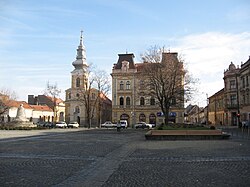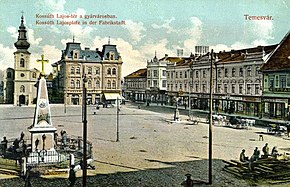George's Church (Fabric)
| George's Church in Fabric | |
|---|---|
|
George's Church in Fabric, 2007 |
|
| Construction time: | 1745-1755 |
| Location: | 45 ° 45 '29.2 " N , 21 ° 15' 0.7" O |
| Address: |
Piața Traian Timișoara Timiș , Romania |
| Purpose: | Serbian Orthodox Church |
| Diocese : | Episcopia Ortodoxă Sârbă Timișoara |
The Church of the Great Martyr St. George ( Romanian Biserica Sfântul Mare Mucenic Gheorghe , also Biserica Sfântul Gheorghe for short ) is a church and a listed historical building on the Piața Traian in the 2nd district of Fabric ( German factory town ) of the western Romanian city of Timișoara ( German Temeswar ). Together with the Serbian Orthodox Cathedral on Piața Unirii in the inner city ( Romanian Cetate ) and the Nicolaikirche on Piața Avram Iancu in the 5th district of Mehala, it is one of the three Serbian Orthodox churches in the city.
history
The church is one of the oldest in Timisoara. Two wooden churches stood here one after the other before 1746. The first was burned down in the course of the Venetian-Austrian Turkish War in 1716 during the Ottoman retreat. Ten years later a new wooden church was built here, but it was torn down after two decades to make room for the current church. This was built in 1745–1755 in the Baroque style while retaining romantic elements , which are particularly evident in the tower and the western entrance. Up until the establishment of a Romanian Orthodox diocese in 1863, Orthodox Romanians and Orthodox Serbs shared the church. The façade tower of the church was attached as an independent structure and heightened in 1890.
The interior of the church was created in 1775 and is the work of the painter Sava Petrovici. The iconostasis of the church was designed in 1764 by the painter Nikola Nescovic from the Academy of Fine Arts in Bratislava (Pressburg) .
The wall painting faded in the course of the 19th century and was replaced with decorations executed in tempera . In 1894 the vault of the church was redesigned by the German painter Gerhard Mentzel.
The right and left votive offerings were created in the first half of the 19th century, they represent the martyrs Saint George and Saint Demetrios .
The twelve apostles and Our Lady Mary in the middle are the only works in tempera that have survived from Nikola Nescovic's original work.
In recent years, the wall painting and iconostasis have been restored by specialists from Novi Sad and Belgrade .
See also
literature
- Ioan Munteanu, Rodica Munteanu: Timișoara monograph . Editura Mirton, Timișoara 2002, ISBN 973-585-650-6 , p. 570 .
- Alexandru Cuțara: Timișoara - Temeswar, picture-art monograph . Editura Amarcord, Timișoara 1998, ISBN 973-9244-35-1 , p. 120 .
- Martin Eichler, Dan Leopold Ciobotaru, Martin Rill: Temeswar - Timișoara. A pearl of the Banat . Wort + Welt + Bild Verlag, Munich 2010, ISBN 978-3-9810825-6-2 .
- Mihai Opriș : Timișoara - Arhitectura de-a lungul veacurilor . 1987 (Romanian).
Web links
- Agenda: Biserica ortodoxa sarba cu hramul "Sfântul Mare Mucenic Gheorghe" , November 11, 2008, in Romanian
- rastko.rs , image of the apostles and Saint Mary
Individual evidence
- ↑ gtztm.ro ( Memento from September 21, 2013 in the Internet Archive ) (PDF; 246 kB), Lista Monumentelor Istorice 2004 des Județ Timiș , TM-II-mA-06169, in Romanian

